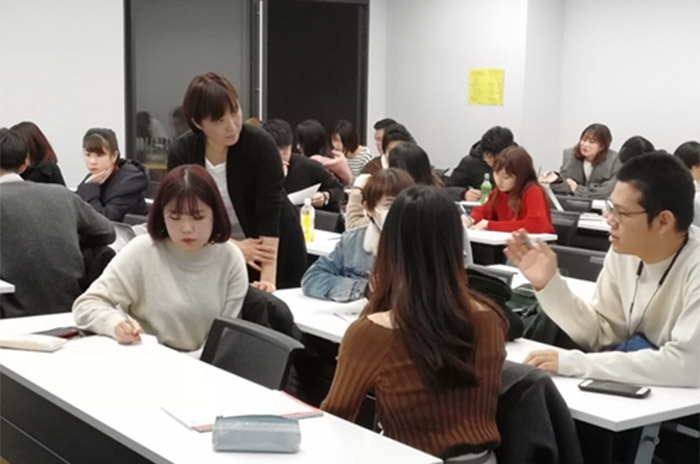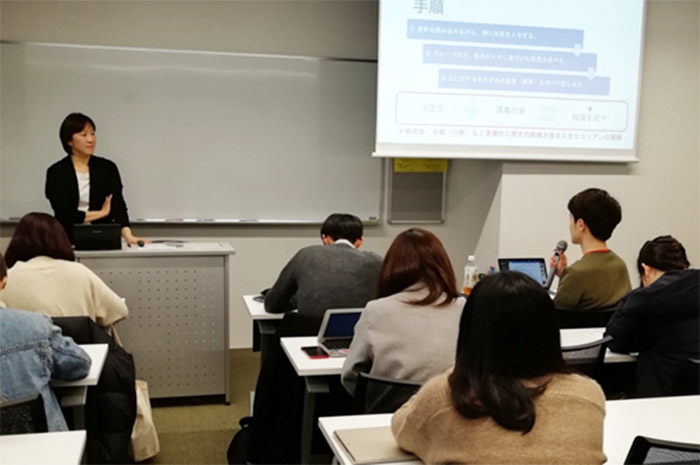Class Introduction:(Special Lecture) Movement of People and Zainichi Koreans
What kind of courses do FGS students usually take, and what do they learn?
This time, we would like to introduce the course “(Special Lecture) Movement of People and Zainichi Koreans” by Professor Kwon Hyangsuk.

Comment from Professor:
Among foreigners in Japan, broadly speaking, there are newcomers who came to Japan recently, and oldcomers (also referred to as old timers in English) who originated from former colonies dating back to pre-war times. This lecture examines the formation process of Zainichi Koreans, known as the largest minority group in Japan post-war, while considering the different historical and cultural backgrounds of these two groups.
As the title “Movement of People and Zainichi Koreans” suggests, this special lecture attempts to reexamine the specific case of Zainichi Koreans from the global phenomenon viewpoint of human movement. Through such work, it aims not only to gain a
multifaceted understanding of Zainichi Koreans, but also to read the blueprint of Japan's society and the world.
As a special lecture (400 Level), the lecture is intended for students with a certain degree of basic knowledge on this subject, but “knowing” and “understanding” are different. With plenty of opportunities for discussions and presentations in addition to lectures, this special lecture aims to provide deep insights and learnings regarding both others, such as Zainichi Koreans, and the students themselves.

Class Interview
I encountered the “comfort women” issue in Gender Studies and developed a strong interest in the subject. However, convincing discussions regarding Japan’s responsibility towards colonial rule are very complicated, and I found limitations in learning by myself. At that time, I learned about this special lecture starting this term and decided to take it because I wanted to accurately learn the history of rule and discrimination against Korea through the issue of Zainichi Koreans. Also, the image of Zainichi Koreans is that they have been at the forefront of racial discrimination in Japanese society until now. Thus, I wanted to learn through this lecture about the mechanisms by which discrimination and exclusion, prejudice, and violence occur.
I am able to learn and organize knowledge about colonial rule and postwar settlement, which are often considered taboo in Japanese school education. Additionally, I can
recognize Zainichi Koreans as people who “coexist with us closely” and come to understand that discrimination and exclusion are not solely their problems, but problems of Japanese society, which represents the majority. There are plenty of opportunities to watch videos and exchange opinions with fellow students, helping them develop the ability to view a problem from various perspectives and think actively.
Many opportunities for small assignments are provided through Moodle which trains students to make their thoughts concise and comprehensible in writing. The teacher introduces recommended books on how to write papers during the class. If you read and practice what’s in these books diligently, you will greatly improve your writing skills, so it's better to take it seriously and work hard, even if you think it might be taken lightly. This is a special lecture offered by the FGS, but it covers the minimum necessary knowledge on matters such as immigration within the lecture. Therefore, even though it is a special lecture, I think students from other faculties can take it without any problems.
(Yasue Kurauchi, Fourth-year, Faculty of Global Studies)
I took this special lecture in the fall of 2019, but even before that, there had been an increase in reports concerning diplomatic issues between Japan and South Korea. Amidst being overwhelmed by news related to the Japan-Korea relationship, including the criticism of the comfort women statue exhibited at the Aichi Triennale and other pieces with discriminatory ideas appearing in books and magazines, I felt the need not only to discern the truth but also to counter such information. Hence, I decided to take this course with the intention of learning more about Zainichi Koreans, forming my own opinions on the subject, and obtaining the foundational knowledge and language to address the prevalent discrimination.
I wasn't the only one who took this lecture to “learn more about the history of Zainichi Koreans;” many others were pursuing the same objective. Learning modern history from the perspective of a minority enriched my knowledge beyond what was taught in high school Japanese history, and from this standpoint, I am very satisfied. Also, there are multiple discussions, and you often engage in debates with students from FGS. This presents a different atmosphere from usual classes and provides an opportunity to learn new perspectives, which is very stimulating.
Throughout the special lecture, we heard several times that the issues faced by Zainichi Koreans till this day encapsulate various contemporary Japanese problems. Indeed, taking this lecture shifted my perspective towards diverse issues, including the treatment of other foreign residents in Japan and problems related to Japanese history education. The lecture provided a catalyst for broadening my interests extensively in
these areas, which I find very appealing.
The lecture content, ranging from historical documents to recent documentaries, offered abundant visual and photographic resources. New perspectives and questions arose from engaging with these materials, reflecting varied observations even on a single piece depending on one’s academic background and previous education, highlighting the difference in interpretations.
(Fourth-year, Department of Journalism, Faculty of Literature)
In this lecture, we examine the historical facts and current situations concerning Zainichi Koreans from various angles. Topics such as nationality, human rights, and legal status enable a deeper understanding of issues confronting Japanese society.
Through taking classes in the Faculty of Global Studies, I have become interested in the movement of people across countries. When I saw the course title, I became intrigued by the possibility of considering the global issue of immigration through more familiar examples. Additionally, by learning about the past and present experiences of Zainichi Koreans within Japanese society, I intended to reflect on future Japan-Korea relations thoughtfully, as well as consider inclusive societies and global immigration issues, thus I decided to take this lecture.
Until now, I have rarely had the opportunity to study the history of Zainichi Koreans. Consequently, every lesson in this lecture has been profoundly stimulating, shocking me with the topics covered and intensifying my awareness of these issues. In particular, I've come to realize that the history I learned in school represents merely a fragment of events. It's important to view history from multiple perspectives considering various standpoints.
The video materials and literature introduced by the teacher will expose us to many voices and experiences of Koreans in Japan. As a result, we have come to recognize that the suffering and discrimination they have experienced are not someone else’s problem, but social issues that we ourselves should address. We believe that these are issues that Japan and the world should work on in order to build a symbiotic society.
Another attractive aspect is the numerous discussions among the students. By exchanging opinions not only with FGS students, but also with students from other faculties, we are able to gain new insights and values. I feel that this is a practical place where we can not only end with input, but also output each other's knowledge and thoughts.
(Marina Horii, Third-year, Faculty of Global Studies)
